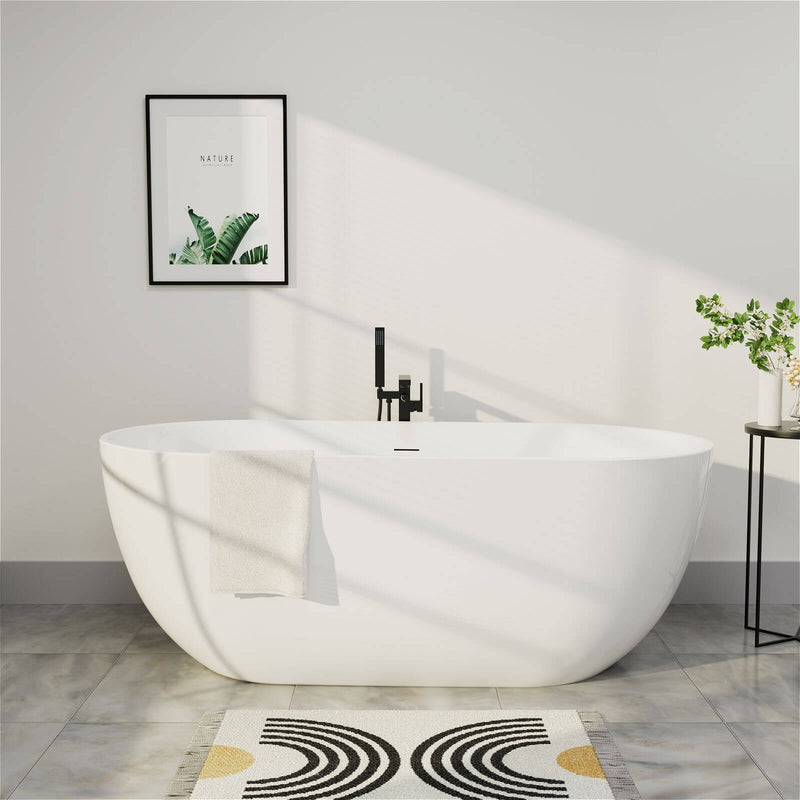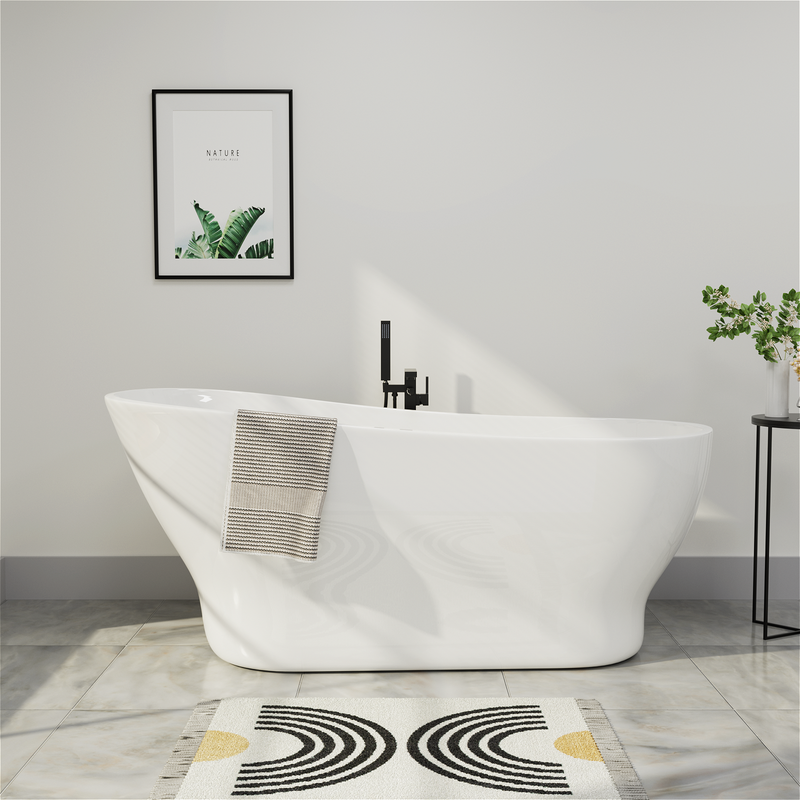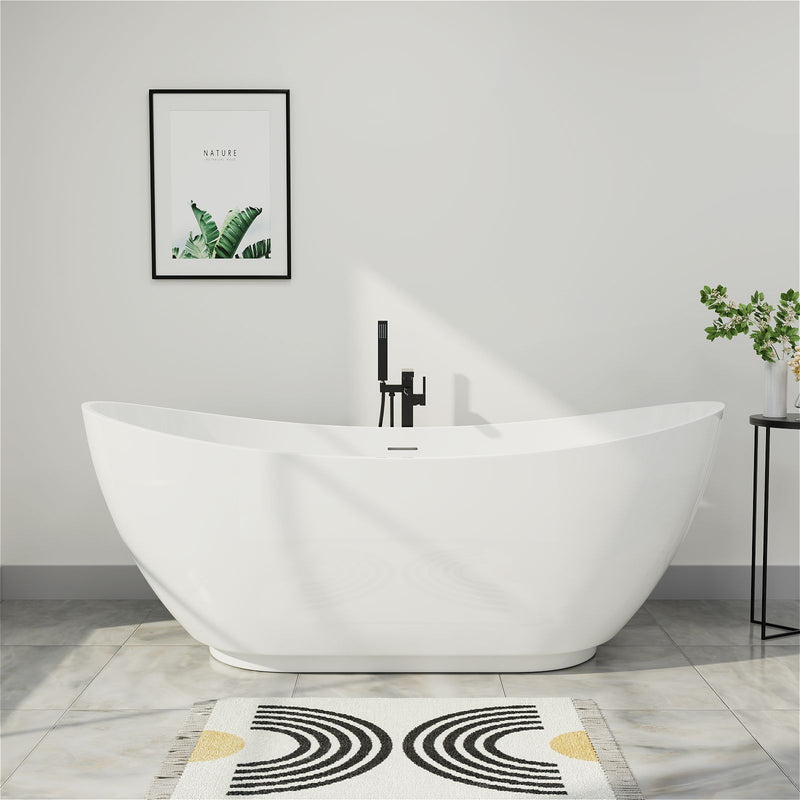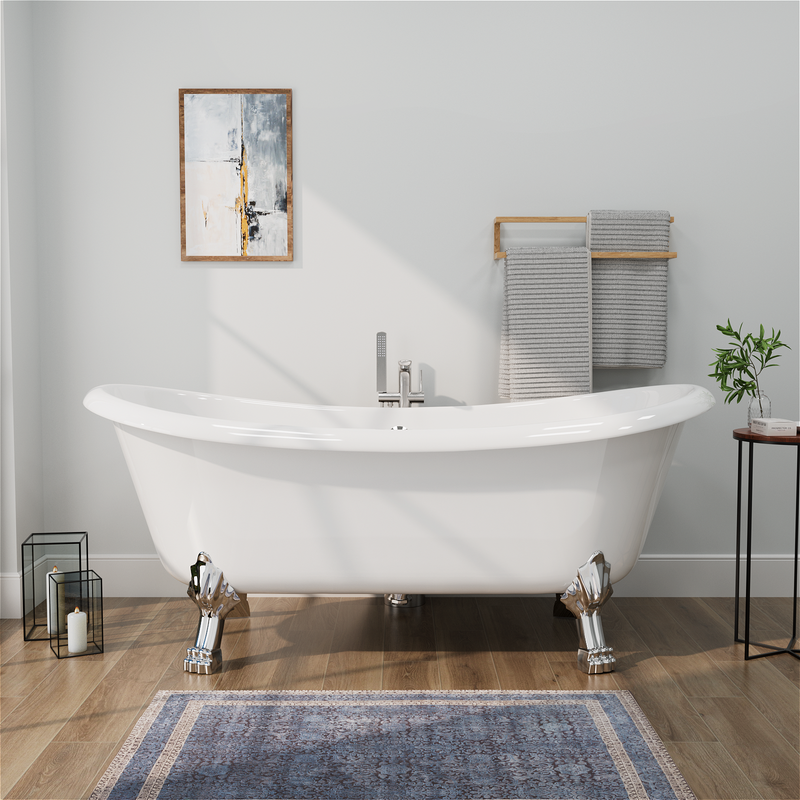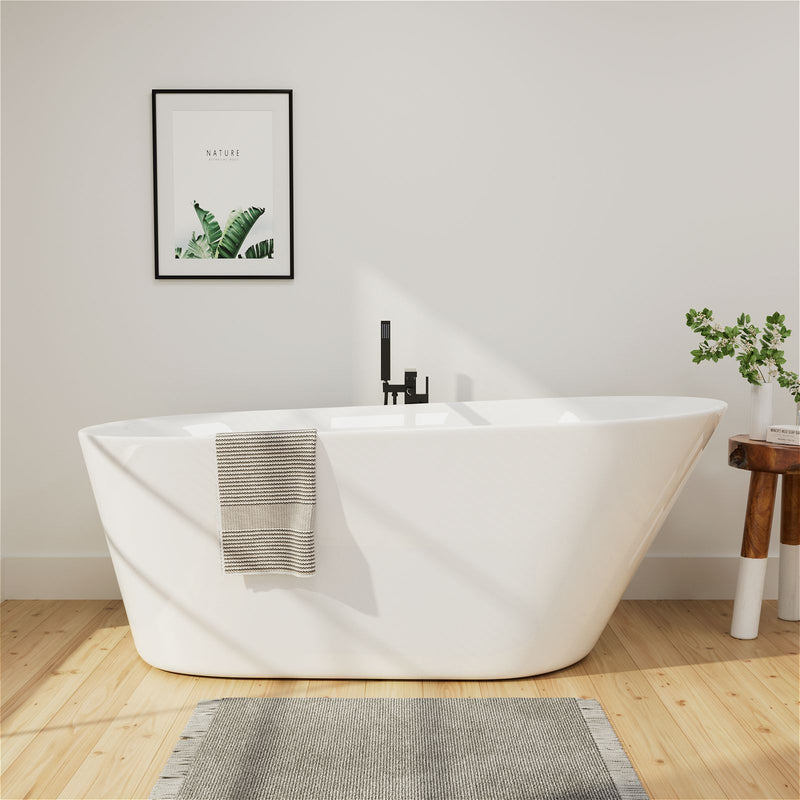Clawfoot bathtubs have long been cherished for their ability to blend classic elegance with personal style, and 2025 is no exception. These timeless fixtures continue to evolve, offering fresh interpretations that cater to both traditional and contemporary aesthetics. Characterized by their iconic raised design and decorative feet, clawfoot tubs serve as stunning focal points in any bathroom, transforming ordinary spaces into luxurious retreats. Modern iterations embrace innovative materials, bold finishes, and ergonomic shapes while maintaining the vintage charm that has made them enduringly popular. This comprehensive guide explores the top clawfoot bathtub styles for 2025, highlighting key trends, materials, and design considerations to help you select the perfect centerpiece for your bathroom sanctuary. From classic rolled-edge designs to contemporary minimalist interpretations, discover how these beautiful tubs can enhance both your bathing experience and your home's aesthetic appeal.
The Classic Rolled-Rim Clawfoot Tub
The classic rolled-rim clawfoot tub remains the most recognizable and timeless style, featuring a gracefully curved edge that provides both visual appeal and practical comfort. This traditional design, often called the "double slipper" variant when featuring raised ends on both sides, allows for comfortable reclining while adding a touch of vintage sophistication to any bathroom. The rolled rim serves as a perfect ledge for bathing accessories and adds structural integrity to the tub's overall design.

In 2025, manufacturers are reimagining this classic with contemporary materials like high-gloss acrylic that offer improved heat retention compared to traditional cast iron. These modern versions maintain the elegant exterior profile while incorporating ergonomic interior contours that enhance bathing comfort. The curved back support and strategically sloped interior accommodate the body's natural positioning, making long soaks genuinely therapeutic. Many homeowners are opting for this style in neutral matte finishes that align with the current preference for subtle sophistication in bathroom design, proving that some classics only improve with age.
Contemporary Minimalist Clawfoot Tubs
For those who prefer clean lines and understated elegance, contemporary minimalist clawfoot tubs offer a fresh take on this traditional fixture. These designs feature straight edges, simple silhouettes, and unadorned surfaces that complement modern bathroom aesthetics without sacrificing the clawfoot's characteristic charm. The minimalist approach focuses on form and function, creating a tub that serves as a sculptural element within the space.
These tubs often incorporate flat-bottom designs that have increased in popularity according to recent bathroom trend studies. This style provides stable footing and easier entry/exit compared to more curved alternatives. The minimalist trend extends to the feet as well, with many contemporary models featuring streamlined foot designs such as simple ball-and-claw or geometric shapes rather than the ornate details of traditional versions. Finished in monochromatic colors like matte black, crisp white, or soft gray, these tubs make a strong style statement through their simplicity rather than decorative elements, perfectly aligning with 2025's preference for clean, uncluttered spaces.
Copper Clawfoot Bathtubs
Copper clawfoot bathtubs make a dramatic statement in any bathroom, offering both visual warmth and natural antimicrobial properties. These stunning tubs develop a unique patina over time, creating a living finish that evolves with your home. The rich, warm tones of copper provide an inviting focal point that complements various design styles, from rustic to industrial to traditional.

Modern copper tubs like the Heisenberg model showcase how this ancient material can feel fresh and contemporary. These tubs often feature hand-cast bronze feet that provide both structural support and decorative appeal, creating a beautiful contrast with the copper basin. The material's natural thermal properties keep bathwater warmer for longer periods, enhancing the bathing experience. While copper tubs represent a significant investment, their durability and timeless appeal make them a valuable addition to luxury bathrooms. Proper maintenance including occasional waxing helps preserve the finish, though many owners appreciate the character that develops as the natural patina emerges over years of use.
Slipper Clawfoot Tubs
Slipper clawfoot tubs, characterized by their raised back that resembles a slipper, offer exceptional comfort for long, leisurely soaks. This design elevates the bather's head and shoulders, providing optimal support for reading, relaxing, or simply enjoying the steam from a warm bath. In 2025, single-ended slipper tubs remain popular, though double slipper designs that feature raised ends on both sides are gaining traction among couples who enjoy bathing together.
Contemporary slipper tubs often incorporate advanced acrylic composites that maintain water temperature more effectively than traditional materials. The elevated design not only enhances comfort but also creates a striking visual profile that commands attention in the bathroom. Many modern iterations feature integrated armrests and contoured lumbar support that align with the body's natural curves, transforming the bathing experience into true hydrotherapy. As bathrooms increasingly become personal sanctuaries, the slipper tub's perfect balance of form and function makes it particularly relevant for 2025's focus on wellness-centered design.
Double-Ended Clawfoot Tubs
Double-ended clawfoot tubs feature symmetrical shapes with bathing accommodations at both ends, making them ideal for shared bathroom spaces. This balanced design offers flexibility in installation and use, as the tub can be accessed comfortably from either side. The uniform silhouette creates a sense of harmony in the bathroom, appealing to those who prefer balanced, symmetrical design principles.
In 2025, double-ended clawfoot tubs are evolving with more ergonomic interior shapes that provide comfortable seating positions regardless of which end the bather chooses. Many contemporary versions feature textured bottoms for improved safety and integrated lumbar support zones that accommodate different body types. This style particularly suits larger bathrooms where the tub can be positioned as a central focal point rather than pushed against a wall. The symmetrical design also works well in bathroom layouts that feature windows on both sides or when centered beneath a statement light fixture, creating a balanced composition that feels both intentional and inviting.
Colorful Statement Clawfoot Tubs
While white remains a classic choice for clawfoot tubs, 2025 sees growing interest in colorful statement pieces that serve as bold focal points in the bathroom. From deep jewel tones to soft pastels, colored tubs offer an opportunity for personal expression and can either complement or contrast with the overall color scheme. This trend aligns with the broader movement toward personalized spaces that reflect individual style rather than strictly following conventional design rules.

Modern colored tubs often feature durable acrylic finishes that maintain their vibrancy over time, unlike traditional painted surfaces that might chip or fade. The current preference leans toward muted, sophisticated shades like forest green, navy blue, or charcoal gray that provide drama without overwhelming the space. Some manufacturers offer custom color options, allowing homeowners to match existing design elements or create exactly the aesthetic they envision. When selecting a colorful clawfoot tub, consider how the shade will interact with other elements in your bathroom—a bold tub paired with neutral walls and flooring creates maximum impact, while a subtler hue can provide personality without dominating the design.
Matte Finish Clawfoot Tubs
Matte finish clawfoot tubs continue to gain popularity in 2025, reflecting the broader design trend toward tactile, non-reflective surfaces that create a sense of understated luxury. Unlike high-gloss finishes that show water spots and fingerprints, matte surfaces better conceal daily wear while providing a soft, contemporary look that works well in various design schemes.
The matte trend aligns with the M.A.D. (Matte, Asymmetry, Dissimilar Materials) design philosophy noted in 2025 trend forecasts. This finish provides a warm, tactile quality that makes the bathroom feel more inviting and less sterile than traditional glossy surfaces. Matte finishes on clawfoot tubs also tend to be more forgiving when it comes to maintenance, as they don't show water marks as readily as their glossy counterparts. Available in everything from classic white to dramatic black and various neutral tones, matte finish clawfoot tubs offer a contemporary twist on a traditional form that feels both fresh and timeless.
Asymmetrical and Organic Clawfoot Tubs
For those seeking truly unique bathroom statements, asymmetrical and organic clawfoot tubs offer an artistic alternative to traditional symmetrical designs. These tubs often feature free-form shapes, irregular curves, and unexpected proportions that create visual interest and movement in the bathroom. This trend reflects the growing influence of organic design principles that prioritize natural, flowing forms over rigid geometry.

Asymmetrical clawfoot tubs might feature uneven ends, curved silhouettes that evoke natural elements like river stones or sea shells, or unconventional foot placements that challenge traditional design conventions. These artistic pieces serve as functional sculpture in the bathroom, transforming the bathing experience into an aesthetic ritual. While these designs make bold statements, they often incorporate ergonomic considerations that ensure comfort isn't sacrificed for form. The organic trend extends to materials as well, with some manufacturers incorporating stone composites and natural elements that enhance the connection to nature—a key wellness consideration in 2025 bathroom design.
Traditional Ball-and-Claw Foot Tubs
The traditional ball-and-claw foot design remains a beloved classic, featuring detailed feet that grasp a ball or sphere. This ornate style references historical craftsmanship and adds a sense of heritage to any bathroom. In 2025, manufacturers are updating this traditional design with modern materials and production techniques that improve durability and performance while maintaining the intricate details that make it special.
Contemporary versions of the ball-and-claw foot tub often feature lightweight composite materials that replicate the look of traditional cast iron without the excessive weight, making installation easier, particularly in upper-story bathrooms. The feet themselves are available in various finishes including polished chrome, oil-rubbed bronze, and matte black that can either match or contrast with the tub color. While the ball-and-claw design traditionally complemented more ornate bathroom styles, contemporary interior designers often use these tubs to create interesting juxtapositions in modern spaces, pairing traditional details with minimalist elements for a layered, sophisticated look that bridges past and present.
Modern Geometric Clawfoot Tubs
Modern geometric clawfoot tubs feature angular shapes, sharp lines, and architectural profiles that appeal to those with contemporary tastes. These designs reinterpret the traditional clawfoot form through a modern lens, creating striking focal points that feel both artistic and functional. Geometric tubs often feature rectangular, hexagonal, or other polygonal shapes that stand in contrast to the curved forms typically associated with clawfoot designs.
These tubs maintain the elevated profile characteristic of clawfoot designs but exchange traditional curves for clean lines and defined angles that complement modern and industrial-style bathrooms. The feet on geometric tubs often reflect the same design philosophy, featuring architectural forms like squared columns, angular animal paws, or abstract shapes. Despite their contemporary appearance, these tubs prioritize comfort with strategically angled interiors that support the body comfortably. The geometric trend represents perhaps the most dramatic evolution of the clawfoot tub, proving that even the most traditional forms can be reimagined for contemporary sensibilities while maintaining their essential character and function.
Key Considerations When Choosing a Clawfoot Bathtub
Material Choices and Their Impact
Clawfoot tubs are available in various materials, each offering distinct advantages. High-quality acrylic options provide excellent heat retention and are relatively lightweight, making them easier to install in upper-level bathrooms. These modern materials also offer design flexibility, allowing for more ergonomic shapes and custom colors. Traditional cast iron remains prized for its durability and classic appeal, though its significant weight requires proper structural support. Copper tubs offer natural antimicrobial properties and develop a unique patina over time, while stone composite options provide a substantial, luxury feel. Each material has different maintenance requirements, heat retention properties, and cost considerations, making it essential to balance aesthetic preferences with practical concerns when selecting your clawfoot tub.

Size and Placement Considerations
Proper sizing and placement are crucial for both functionality and aesthetics. While clawfoot tubs traditionally require more space than built-in models, many contemporary designs offer space-efficient options suitable for smaller bathrooms. Corner placements can maximize floor space, while central positioning creates a dramatic focal point. When planning your bathroom layout, consider the tub's clearance requirements—you'll need adequate space for cleaning and access to plumbing connections. The tub's weight when filled is another important consideration, particularly for upper-level bathrooms where structural reinforcement might be necessary. Thoughtful placement in relation to windows, lighting, and other fixtures can enhance both the practicality and visual impact of your clawfoot tub, transforming it from merely a functional element into the centerpiece of your bathroom design.
Faucet and Hardware Selection
Clawfoot tubs require specific faucet configurations, typically either freestanding floor-mounted options or wall-mounted designs with extended spouts. The choice between these options affects both the installation process and the final look of your bathroom. Floor-mounted faucets require precise plumbing rough-ins during installation but create a cohesive look with the tub itself. Wall-mounted options need to be positioned carefully to ensure proper clearance and water direction. The hardware finish provides an opportunity to enhance your bathroom's style—matte black offers contemporary contrast, polished chrome provides classic appeal, while warm metallic finishes like bronze or copper can complement traditional or industrial aesthetics. Coordinating the tub's feet with the faucet finish creates a pulled-together look, while intentional contrast can make a more dramatic style statement.
FAQs
Q: Are clawfoot tubs practical for everyday use?
Yes, modern clawfoot tubs are designed for regular use, with many models featuring comfortable ergonomics and practical maintenance considerations. Contemporary materials like high-gloss acrylic are resistant to stains and scratches, making them suitable for daily bathing. The key is selecting a model that fits your space appropriately and meets your comfort needs, whether you prefer deep soaking capabilities or a more standard bathing experience.
Q: How difficult is it to clean around and under a clawfoot tub?
Cleaning around clawfoot tubs requires some additional effort compared to built-in models, but proper planning can minimize challenges. Leaving adequate clearance between the tub and walls (at least 4-6 inches) facilitates access for cleaning. Many homeowners find a long-handled duster or vacuum attachment helpful for reaching underneath the tub. Regular dusting or vacuuming prevents accumulation that becomes more difficult to remove over time.
Q: Can I install a shower with a clawfoot tub?
Yes, clawfoot tubs can be outfitted with shower systems using either a ceiling-mounted shower ring or a wall-mounted shower arm with a curtain rod that encircles the tub. This configuration requires proper waterproofing measures, including a sufficient curtain that completely contains water spray and possibly a floor drain or waterproof flooring to handle any overflow. Many homeowners find the combination of tub and shower functionality worth the additional installation considerations.
Q: What type of flooring works best with clawfoot tubs?
Clawfoot tubs work with virtually any waterproof flooring material, though some considerations apply. Non-porous options like tile, vinyl, or sealed concrete are practical choices that handle potential water exposure. The significant weight of filled clawfoot tubs, particularly cast iron models, requires structurally sound flooring that may need reinforcement in some cases. A properly installed bathroom floor with appropriate slope toward drains helps manage any water that escapes during shower use.
Q: Are clawfoot tubs comfortable for people of different heights?
Clawfoot tubs are available in various sizes and configurations to accommodate different body types and preferences. Longer models (67-72 inches) comfortably fit most adults, while deeper designs allow for full immersion regardless of height. The curved interior contours of many clawfoot tubs provide comfortable support for various reclining positions. When selecting a tub, consider both the exterior dimensions and interior bathing well size to ensure comfortable use for all household members.
Q: How do clawfoot tubs affect home resale value?
Well-chosen clawfoot tubs typically add character and value to homes, particularly when they align with the property's overall style. Their classic appeal and statement-making potential can differentiate your home in the real estate market. While not every buyer prioritizes a bathtub, those who do often appreciate the luxury and aesthetic appeal of a beautiful clawfoot tub. The key is ensuring the tub complements rather than conflicts with your bathroom's overall design and functionality.
Conclusion
Clawfoot bathtubs continue to evolve while maintaining their essential character, offering diverse styles to suit various tastes and bathroom configurations. The 2025 trends highlight both a return to classic elegance and an embrace of contemporary innovation, with options ranging from traditional rolled-rim designs to bold geometric statements. Material advancements, finish options, and ergonomic improvements ensure that today's clawfoot tubs provide both aesthetic appeal and practical performance. When selecting your ideal clawfoot tub, consider how each style complements your bathroom's overall design while meeting your functional needs and personal preferences. The perfect clawfoot tub serves not just as a bathing vessel but as a centerpiece that elevates your entire bathroom experience, creating a personal sanctuary that balances timeless appeal with contemporary comfort.

